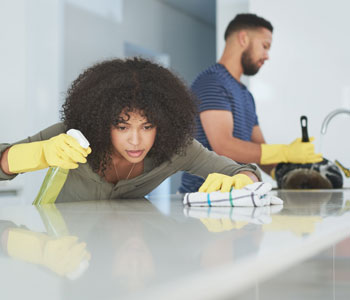Disinfecting your home to kill viruses
Virus can remain on cardboard, copper, plastic and steel from hours to days

As coronavirus spreads around the globe, millions of people are being told to wash their hands.
But your hands aren’t the only things you need to keep clean. Researchers have found that the virus can remain on cardboard, copper, plastic and steel from hours to days.
Regular cleaning of surfaces with effective disinfectants is another weapon in the fight against the virus that causes COVID-19. Infectious disease experts say that doing so can help reduce the spread of the illness.
How long does COVID-19 live?
A recent study by the National Institutes of Health (NIH) found that coronavirus can live on surfaces for:
- Four hours on copper
- 4 hours on cardboard Two to three days on plastic and stainless steel
The good news is that cleaning and disinfecting indoor surfaces can shorten the virus’s lifespan, provided it’s done correctly – clean first, then disinfect, according to the Centers for Disease Control and Prevention (CDC).
The purpose of cleaning before disinfecting is to remove as many germs as possible to decrease the risk of spreading infection. Following up with disinfectant on remaining germs kills remaining germs and further reduces the spread of infection.
Focus on high-touch surfaces
The CDC recommends frequent cleaning and disinfecting of high-touch surfaces. These include:
- Tables
- Doorknobs
- Light switches
- Handles
- Desks
- Toilets
- Faucets
- Sinks
Use standard household cleaners and EPA-registered disinfectants on these surfaces.
Cleaning and disinfecting
When a surface is dirty, clean it using detergent or soap and water before disinfecting.
Afterward, use diluted household bleach solutions, alcohol solutions with at least 70% alcohol, or other household disinfectants recommended by the U.S. Environmental Protection agency to combat coronavirus.
Follow label instructions on standard household cleaners such as:
- Alcohol-based wipes (no baby wipes)
- Clorox
- Lysol
- Microban
- Hydrogen peroxide
Never mix household bleach with ammonia or any other cleanser. You can prepare your own bleach solution by:
- Mixing 5 tablespoons bleach per gallon of water or
- Mixing 4 teaspoons bleach per quart of water
Be sure to protect yourself while cleaning and disinfecting by wearing gloves and ensuring good ventilation. If you use disposable gloves, discard them after use. If you have reusable gloves, clean and store them in a dry location.
Be sure to clean your hands immediately after removing gloves.
Cleaning when someone has COVID-19
Anyone who has COVID-19 should sequester in a specific room. Clean the sick person’s space as needed to avoid unnecessary contact and exposure to the virus.
If you share a bathroom, clean and disinfect all surfaces after each use by the ill person.
Again, always wear gloves when cleaning and disinfecting for COVID-19. And be sure to clean your hands immediately after removing gloves.
An ill person should also eat in the room they are staying in to minimize spreading the virus. Always handle non-disposable food items like utensils and plates with gloves and wash with soap and hot water. Be sure to clean hands after handling these items and after disposing trash.
Laundry guidelines and COVID-19
Launder clothing, towels, linens, and other items according to manufacturer instructions but be sure to:
- Use the warmest water setting possible to kill germs.
- Minimize shaking of contaminated items before placing in the washer to limit the dispersion of particles.
- Wear gloves when handling an ill person’s laundry.
- Always clean your hands immediately after removing gloves.
Normal washing with laundry detergents, hot water and hot dryers are good for killing pathogens, UCI infectious disease experts say. If you cannot wash clothes right away, it’s OK to put them in a laundry basket. Virus degrades and deteriorates over time without a live host.
Even if viruses are on clothing, the only way to get sick is by rubbing hands on the cloth right after a droplet spray and then touching mouth, eyes or nose without washing hands.
Hand hygiene
Caregivers and others living in a household with a patient who has COVID-19 should be sure to clean their hands frequently with soap and warm water for 20 seconds, especially after removing gloves or being in contact with the ill person.
CDC guidelines call for handwashing if hands are visibly soiled, before eating and after using the restroom. Otherwise using a hand sanitizer with at least 60% alcohol is effective, and often easier and more accessible.
Be sure to practice normal preventive measures and wash your hands:
- After blowing your nose, coughing, or sneezing
- After using a bathroom
- Before eating or preparing food
- After contact with pets or other animals
You’ve heard it before for a reason: Avoid touching your eyes, nose or mouth, and wipe the surfaces of remote controls, phones, tablets and other high-touch surfaces at home and in your car with a good disinfectant wipe.




